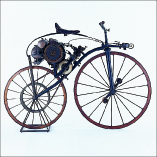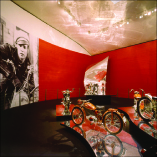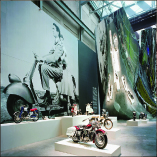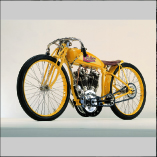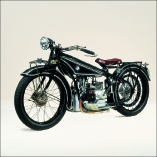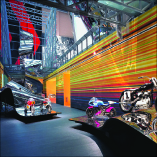SPEED, PLEASURE AND TECHNOLOGY
The motorcycle is a perfect metaphor for the 20th century. Invented at the beginning of the industrial age, its evolution tracks the main currents of modernity. The object and its history represent the themes of technology, engineering, innovation, design, mobility, speed, rebellion, desire, freedom, love, sex, and death. For much of society, the motorcycle remains a forbidden indulgence, an object of fascination, fantasy, and danger. As a practical machine whose history has been one of relentless improvements and design evolution, the motorcycle as a form class at the end of the 20th century embodies its own end-game paradox. Logic and physics suggest it has reached the end of its evolutionary potential, but somehow we know that cannot be completely true. As such, however, it is a quintessential symbol of the insecurity and optimism of our time. Thus, the exhibition Speed, Pleasure and Technology: The New Art of the Motorcycle explores the history of motorcycle design as an aesthetic, cultural, and technological object. It features over 120 motorcycles dating from 1868 to 2011, which together chronicle the most compelling moments in motorcycle design and technology. The history of the motorcycle describes the history and evolution of modern age.
From 1868-71, Louis Perreaux installed and patented a steam engine in the first commercially successful pedal bicycle; by 1894, the Hildebrand brothers and Alois Wolfmuller had patented a water-cooled, two-cylinder gasoline engine in a bicycle frame, the first commercially produced motorcycle with an internal-combustion engine. More than a product of the industrial revolution, the motorcycle quickly took on broader significance. Embodying the more abstract themes of speed, rebellion, progress, freedom, sex, and danger, the motorcycle has been immortalized as a cultural icon that has been transformed with the times. The limits imposed by the possible form and function of the motorcycle, and the breadth of variation that have been expressed within these limitations, provide a vehicle for examining the motorcycle as a possible metaphor for the 20th century.
The criteria for selecting and presenting the motorcycles are fairly straightforward. Except for the seven pre-production motorcycles that open the exhibition, the selection not only spans the century of motorcycle production that evolved from the first patented combination of steam engine and bicycle frame in 1868, but also the technological progress and the cultural, sociological, and economic factors that define and characterize the 20th century. In addition to these, marketing, the expectations and desires of consumers, and the ebb and flow of national economies are all manifested in the components and form of the motorcycle. The sheer number of types of motorcycles – production, studio-built one-offs, customized, sidecar additions, and the many categories of motorcycle racing – is vast. To extract a narrative from the array of functions and dictates that motorcycles represent, the choices have been refined to a group of singularly 20th century defining elements: technological innovation, design excellence and aesthetics, and social function. All of the motorcycles in the exhibition are a product of more than one of these criteria

